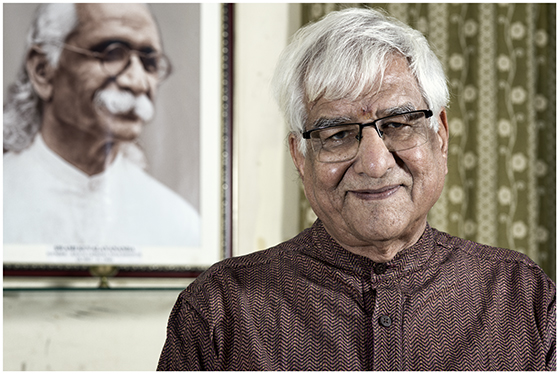
Photo Credit – Coni Hörler
O.P. Tiwari (*1933 in North India) is one of the great living Pranayama masters of India. He is a direct disciple of Swami Kuvalayananda, the founder of Kaivalyadhama Lonavla Institute and Ashram. For many years he was the leader of this world-renowned institute, which links Yoga tradition and science. With great integrity, he has been teaching now for more than 50 years, following the classical approach by Patanjali. We are honoured to share his insights on the practice of Pranayama.
This is the first published article of a series of our interviews with Yoga masters in India.
What does Patanjali say about Pranayama?
O.P. Tiwari: Patanjali clearly states that you are ready for practising Pranayama once you have become accomplished in sitting in a meditative posture. This is because the effect of Pranayama is defiled if there is no steadiness in the sitting posture, due to, for instance, the variation of pressure in the lungs. Patanjali goes on to describe Pranayama as the wilful extending, shortening or stopping of the breath. He assumes that everyone has one definite flow with a definite speed to inhale and exhale and that this goes on 24 hours.

What is the role of Pranayama on the Yogic (spiritual) path?
O.P. Tiwari: The subject matter of all Indian philosophy is not about the existence or not of God but whether humanity is happy or not and the reasons why. According to Western psychology, whenever a person is abnormal, they conclude that there is a problem in the mind. Yoga and Indian philosophy, in general, will not say that, but that mind itself is the problem. Desires come from the mind, as it does not know what the real need is and what is only desire. According to Yoga, nothing is as close to your mind as your breath. If I start insulting you, anger will come immediately and your breath will change, in different moods, there are different patterns of breath, so if you can control the breathing you will control the mind. They are interdependent. Once you go beyond the mind and know what is the difference between needs and desires, you enter your inner space. Mostly, we remain in the outer space because the mind always desires, thinking that the more desires you fulfil, the happier you will be. This is not so, because you cannot fulfil hundreds of desires. This is the function of pranayama in the spiritual path.
Are Asanas and Pranayama directly linked? Should they be practised together?
O.P. Tiwari: Some modern schools mix breathing with postures. Patanjali clearly separated them into different chapters. Had he wanted the two to be mixed, he could have easily done so, because he believed the body has a mechanism to adjust breathing as the situation requires. Some traditions may allow this mixing, but the lineage that comes directly from Patanjali does not allow for asanas to be mixed with Pranayama; they are separate disciplines that have to be learned in steps. After Asanas, comes Pranayama.

What is the right time for practising Pranayama?
O.P. Tiwari: It can be practised at any time, but it is most effective if you first relax your body with asanas and then you do Pranayama. Pranayama has certain restrictions that you have to take into account. My teacher discovered that practising Pranayama increases CO2 intake, which can be harmful, so you have to take precautions. This is accounted for, in the tradition, by practising in stages: suppose normally you are inhaling in 2 seconds, exhaling in 2 seconds; we might start by increasing exhalation to 4 seconds, so you get used to the extra CO2 slowly and there is no ill effect; after 3 months we might increase the exhalation again. Precaution must be taught or it can be harmful. Control of the breath is gained slowly, just like taming lions and elephants, which are not tamed in one day.
What is the most common mistake in Pranayama?
O.P. Tiwari: The most common mistake is holding the breath for too long. If the teacher has said to hold the breath for only 10 seconds, you might think: ‘Ah, I can make it 20 seconds.’ This is a common mistake that must be avoided. It is important to never practice Pranayama alone, by reading books. Take the help of a teacher and learn from his experience. However, today we have seen teachers who do not know about Hathapradipika but they are teaching Pranayama! It is necessary that a teacher know theoretical knowledge and the work that is done in the field of Pranayama.
For those of you who would like to learn more from one of the oldest Yoga Institutes of the world: Join the shortest Yoga Teacher Training in India!
We currently offer a blended Yoga Teacher Training Course in the recognised 200 hrs format together with KaivalyaDhama Institute and Ashram (at an exclusive 10% discount for Yoga.in users). This course has two parts: For the theoretical part, you can study self-paced at your home in your own time via online learning. The postural practice, for final certification, is covered in 2 weeks intensive at KaivalyaDhama Institute and Ashram in India. See information on this online Yoga Teacher Training Course.
This interview is part of the book ‚Zu den Quellen des Yoga‘ / ‘To the sources of Yoga’. This book introduces you to the outstanding Indian Yoga schools and masters, their traditions and their practice. It answers the questions ‘What is Yoga?’, ‘What are the aims of Yoga?’ and ‘How do we best reach these aims?’ from an entire Indian perspective. This book was produced in cooperation with Yoga.in and is published in Germany by Random House/Irisiana.
We are currently looking for a publisher of an English version – ideally from India.

I would like to visit kaivalidham ashram.
LikeLike
Very informative article .thank you for sharing this.
LikeLike